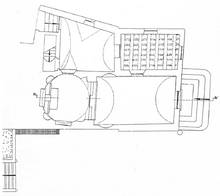Santa Maria del Riposo is a 16th century subsidiary church of the parish of San Pio V at Via Aurelia 327, near the Baldo degli Ubaldi metro station in the Aurelio quarter south-west of Vatican City.
The dedication is to the Blessed Virgin Mary, under her title of "Our Lady of Rest".
History[]
This tiny, simple church was built by Pope Pius IV in the early 16th century, in what was then a wholly rural location. It is thought that it replaced an earlier chapel, but this remains uncertain. There is a mention in the chronicle of Antonio dello Schiavo, around the start of the 15th century, of a chapel called Madonna del Riposo which is possibly the ancestor of this church.
It was often visited by Pope St Pius V on is way to and from his summer villa further along the Via Aurelia, which is why his coat of arms is below the triangular pediment. He had a Casale or house behind the church, but this was demolished in 1958 (the gateway survives).
There was a restoration in 1930, when the property was deeded to the Diocese.
As a place of worship it was supplanted by the new parish church of San Pio V in 1952, but was kept on as a subsidiary Mass centre -a function that it still performs. Another restoration took place in 1958 on the orders of Pope Pius XII, part of the same project that led to the demolition of the adjacent Casale for a small apartment block.
A re-painting of the façade occurred recently.
Exterior[]
Layout and fabric[]
The church is truly small, a small rectangular brick box with a tiny semi-circular apse. The latter is invisible from the street, as the church has sacristy and priests' accommodation attached behind and to the right. The range to the right is in two two-storey structural units at a slight angle to each other. On the ridge of their common roof is the campanile or bellcote, having a single round-headed housing for the bell and a triangular pediment above.
The façade below the pediment simply has the door, a rectangular window above and an overall stone frame, without any detailing except for the title Madonna del Riposo either side of the coat of arms.
The gateway to the lost casale is to the right. A steep set of stairs leads to a rectangular portal in rusticated stone blocks, the piers being in travertine and the lintel in tufa which gives a colour contrast. A pair of urns carved in tufa sit on top of the piers.
Façade[]
The façade has recently been painted in very pale yellow with the architectural details in light grey -it used to be uniformly in yellow ochre.
There is a set of steps leading up to the door, because the church is over a cellar or crypt (you can see a row of air-holes in the bottom of the right hand range). The rectangular doorway has a rectangular transom window above it, of the same width. Very shallow blind pilasters occupy the corners, and support an entablature with a very thin molded architrave and a dedicatory inscription on the frieze -Madonna del Riposo. This is defaced by a small coat-of-arms of Pope St Pius V. Above is a triangular pediment.
Interior[]
Layout and fabric[]

The interior walls are attractively painted to resemble polychrome marble cladding, depicting Doric pilasters in yellow marble on a background of pink. There is a barrel vaulted ceiling.
The sanctuary is flanked by two large display cases containing ex votos donated by grateful venerators of the icon. The floor contains a polychrome marble setting of the coat-of-arms of Pope Pius XII, inserted in 1958. Also to one side is a tablet recalling the donation of the property to the Diocese by Pericle Straderini in 1930, with a relief heraldic shield.
Sanctuary[]
The altarpice itself is thought to be 15th century, and shows the Madonna and Child on a stone throne in Grotesque style. It is within an early Baroque frame, and has at its base a band of putti with musical instruments. The throne and band were definitely added later.
The vault of the apse has a little fresco of The Coronation of Our Lady, perhaps 17th century.
The frontal of the little altar has polychrome marble inlay including the lilies of the Farnese family, and probably did not belong here originally.
Liturgy[]
This remains a working church. Mass is celebrated (parish website, June 2018):
Weekdays 7:30, 17:00;
Sundays and Solemnities 7:30, 10:30.